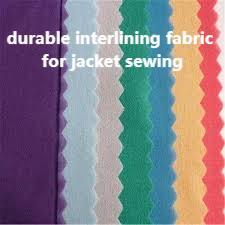In contemporary garment engineering, Interlining serves as the invisible backbone that defines fit and finish, and designers depend on the right choice to achieve consistent results; a well-specified Interlining establishes collar shape, lapel resilience, and smooth cuff edges without compromising wearer comfort. This article explores the decisions, tests, and production practices that turn an unseen layer into a measurable advantage for apparel quality, factory efficiency, and consumer satisfaction.
Understanding the functional role of support layers
Garments that appear crisp and well-tailored rely on a layer that provides targeted reinforcement. That layer must deliver stiffness where needed and flexibility elsewhere, so designers choose substrate types and bonding techniques according to the garment’s intended use. For tailored jackets, a firmer support gives sharp lapels and stable collars. For casual or performance wear, softer options preserve drape and motion. Thinking in terms of zones—shoulder support, collar reinforcement, and front-panel stability—helps technical teams distribute performance without adding unnecessary bulk.
Substrate choices and construction methods
There are three broad construction families used in production: woven, knitted, and non-woven. Woven supports excel at dimensional control; knitted supports give stretch and recovery; non-woven laminates provide uniform thickness and cost efficiency. Each base behaves differently under heat and tension, so selection must consider fabric type and pressing process. Bonding approaches—hot-melt adhesives, thermal lamination, needle-punching, or stitch-through attachment—determine seam behavior, laundering performance, and hand feel. Proper trials reveal how each combination reacts during repeated care cycles and industrial pressing.
Balancing hand, drape, and structural performance
The tactile impression of a garment matters as much as its silhouette. A support layer must not create a plasticky hand or a noisy rustle. Testing focuses on bending stiffness, thickness uniformity, and compressibility to ensure panels lie flat and seams finish cleanly. Wearer trials help correlate instrument readings with real-world perception—what tests measure for rigidity may still feel acceptable or uncomfortable depending on fabric weight and garment cut. Iterative prototyping, involving pattern adjustments and multiple support-weight trials, yields a refined balance.
Durability, testing, and quality assurance
Long-term performance is driven by adhesive stability, dimensional tolerance, and heat-resistance under pressing. Peel strength tests quantify adhesion between layers; cyclic wash and tumble cycles predict life expectancy; thermal aging checks simulate repeated pressing and storage. Inline quality control—thickness gauging, bond-coverage imaging, and batch traceability—catches deviations before large production runs. Suppliers who provide detailed test certificates and small-sample validation kits reduce risk and speed approval in production ramps.
Process integration and production efficiencies
Successful integration begins early in the product lifecycle. Including support-layer specifications in technical packs prevents last-minute substitutions that can cause puckering or delamination. Pre-pressed kits, registered laminates, and graded support strategies reduce line changeover time. Training press operators on temperature profiles and dwell times ensures consistent bonding; documenting pressing windows and conveyor speed prevents process drift. When pattern pieces arrive pre-labeled with their corresponding reinforcement, assembly lines run smoother and reject rates fall.
Sustainability and material lifecycle considerations
Environmental pressures push manufacturers toward lower-impact substrates and adhesives. Recycled fiber blanks, water-based adhesives, and reduced-energy bonding methods are increasingly available without large performance penalties. Lifecycle assessments compare initial performance with end-of-life impacts—choices that modestly increase recycled content can dramatically lower a garment’s footprint when scaled. Manufacturers evaluating eco-options should require equivalent mechanical testing and certify recyclability or compostability where practical.
Selecting the right supplier and managing supply risk
Choosing a reliable source involves more than price. Evaluate a supplier’s quality system, their capacity to supply consistent batches, and the transparency of their test data. Joint development programs, where designers, sourcing, and supplier engineers iterate prototypes together, reduce surprises at scale. Maintain a small, qualified list of alternate suppliers and keep critical technical parameters in contracts to avoid mismatches when shortages occur.
Practical guidance for specifiers and designers
Start by defining the desired outcome—shape retention, thermal insulation, reinforcement, or opacity. Test candidate laminates on the actual face fabric, run representative care cycles, and evaluate hand panels and wear trials. Specify acceptable tolerances for thickness and adhesion and require traceable batch data. Use graded support in complex garments to optimize comfort and structure. Finally, document pressing parameters and provide clear assembly instructions to production teams.
When hidden layers are chosen and integrated with care, finished garments demonstrate better fit, longer life, and reduced returns. Thoughtful material selection, rigorous testing, and close collaboration between design and production turn a small internal component into a major advantage for brands and manufacturers alike. For technical references, case studies, and detailed application guidance, visit https://www.interlining-factory.com/news/what-is-interlining-types-applications-and-more.html

